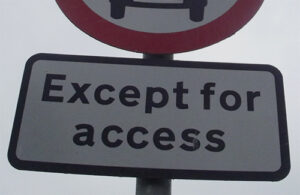Associations and institutions are welcome to apply to become members of the ALCC.
One of the ways you can use material without the permission of the copyright owner is using an exception to copyright.

Exceptions are an important part of the copyright system.
Photo: Elliott Brown. CC BY 2.0. Full attribution information below.
There are specific limits and exceptions built into copyright to encourage the sharing of knowledge. If you don’t have permission to use copyright protected material there may be an exception that allows use without infringing copyright. Basically, if you meet the requirements of an exception then a permitted use is not an infringement. But, importantly, exceptions are not a free-for-all.
Copyright exceptions play a crucial role in establishing an appropriate balance between incentivising creativity by protecting creators interest in their creative outputs, while also encouraging the dissemination of knowledge by allowing the public to legitimately engage with creative material for socially beneficial purposes such as education, research, criticism, review, news reporting, preserving our collective heritage and other public interest pursuits. Copyright exceptions delineate the boundaries of copyright owners’ exclusive rights while providing needed flexibility in the copyright system.
The Australian Copyright Act 1968 has more than 90 exceptions. The most well known and commonly used are the fair dealing exceptions. There are many other specific exceptions that cover activities like reading aloud, taking photographs of public statues and technical reproductions that occur as part of the technical process of making or receiving a communication.
Fair dealing exceptions
The Copyright Act includes a group of exceptions called the fair dealing exceptions. They allow uses of copyright protected material for specific purposes such as research, review or parody where those uses are fair. For more on the fair dealing exceptions see: The fair dealing exceptions.
Libraries and archives exceptions
There are a number of specific exceptions to copyright that allow libraries, archives and cultural institutions with collections (such as galleries and museums) to use some copyright material for specific purposes such as supplying materials to users, preserving items in the collection and administering the collection. For more information about the library and archive exceptions see: The libraries and archives exceptions.
Private copying exceptions – format- and time-shifting
There are some exceptions for private copying, the main two exceptions are for format-shifting and time-shifting. Format-shifting allows you to copy certain types of material that you own for private and domestic use into a different ‘format’ – e.g. copying a CD to MP3 format. The time-shifting exception allows you to record a television or radio broadcast to watch or listen to it later. Both provisions are for personal use only.
Sometimes members of the public will try to rely on these provisions to copy items in collections. Generally the person seeking to format shift material must be the own of the material in the original format and be the one to make the new format. Similarly a person seeking to rely on the time-shifting exception must have been the one to record the broadcast.
Other exceptions
There are a range of other exceptions to copyright that exist in the Copyright Act, many of which are for specific situations. These include:
- Section 65 allows people to paint, draw, engrave or photograph a sculpture or a work of artistic craftsmanship that is on permanent public display. It also allows the inclusion of such works in a film or television broadcast.
- Section 66 means that a person can undertake the same activities – painting, drawing, engraving, photographing, filming or broadcasting – a building or model of a building.
- Under section 45 the reading or recitation in public or in a radio or television broadcast of an extract of reasonable length from a published literary or dramatic work, or from an adaptation of a published literary or dramatic work, does not constitute an infringement. However sufficient acknowledgement of the work must be made.
- Section 67 means that the inclusion of an artistic work in a film or a television broadcast is not an infringement if its inclusion “is only incidental to the principal matters represented in the film or broadcast”.
- The temporary copies of works (e.g. caching) or other subject-matter that are created as part of the technical process of making or receiving a communication or using a copy of the work or other subject-matter are not infringements. This is outlined in sections 43A, 43B, 111A and 111B.
- It is also not an infringement to reconstruct a building by virtue of section 73. This including where a building has been constructed in accordance with architectural drawings or plans and a later reconstruction is undertaken with reference to those drawings or plans.
If you want a comprehensive list of exceptions in the Act we recommend you look at the Australian Copyright Council’s Exceptions to Copyright Infringement factsheet.
